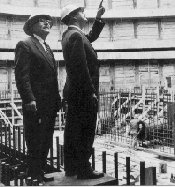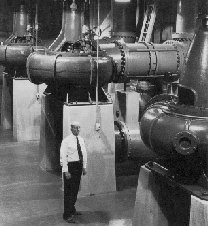While the bold consolidation plan was defeated, the need for a comprehensive plan was never more evident. The scope of the plan, however, would become a compromise.
The first proposal was for a countywide sewer and drainage plan. Louisville’s city government balked, however, saying its drainage needs were pressing and immediate, and preparing a countywide plan would take too long. Similarly, Louisville was depending on MSD to carry out the plan to extend sanitary sewers to the areas of the city without them; this sewer expansion plan was being carried out as finances allowed.
The scope of the study was revised to include only sanitary sewer expansion outside the City of Louisville. In 1962, Jefferson Fiscal Court agreed to pay $200,000 for a plan for extending sanitary sewer service throughout the urbanized areas of the county by the year 2010.
The study took two years. It included extensive research into the current and future conditions throughout the county, including anticipated growth.
The master plan divided the county into six study areas, which would provide the framework for sewer planning and construction for decades to come: North County, Middle Fork of Beargrass Creek, South Fork of Beargrass Creek, Pond Creek, West County and Floyds Fork.
It recommended two major new treatment plants: North County, between the Louisville Water Company water tower and Beargrass Creek, and West County, along Lower River Road. And it recommended smaller treatment plants to provide service as land developed in the Floyds Fork watershed.
The cost estimate: $279 million, in 1964 dollars.


Courier-Journal and Louisville Times Photos
The problem of financing however, was only partly solved. A law passed by the 1964 legislature allowed for the formation of sewer construction subdistricts. The money for construction would be raised by selling bonds, which would be paid off by the income from assessments on the properties served.
Later in 1964, the first subdistrict was formed. It served a part of the Middle Fork basin of Beargrass Creek, where the health department had banned septic tanks. Financing was to be through monthly fees, which eventually were set at more than three times MSD’s rates. The system would carry its wastewater to MSD’s lines, and MSD would handle it from there. Once the bonds had been paid off, the subdistrict’s sewer system would become a part of MSD, and the rates would drop to MSD’s normal rates.
For the next six years, the subdistrict system would be used to expand sewers to several suburban areas of Jefferson County.
New federal clean-water programs also helped. Beginning in 1965, the federal government began a program that would pay up to 30 percent of the cost of installing suburban sewer lines.
But local financing for the big items — the treatment plants and the trunk sewers needed to feed them — continued to be a problem.
The master plan also recommended that MSD take over small sewer systems, and the "temporary" treatment plants, as its service area reached them. This, too, would eventually happen — but only after controversial legal and political battles.
MSD History continued - The 1964 Flood


